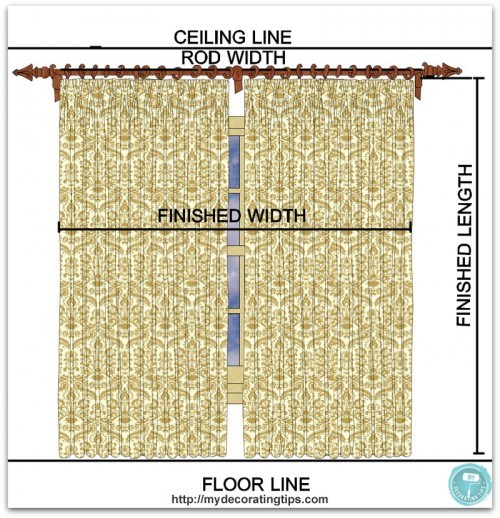What is the cost of the fabric for those pretty window curtains I want to make?
This could be the first question that crossed your mind when you started dreaming about getting (or making) curtains for your home. So, you might have been putting this project away, right? Perhaps, this drapery yardage calculator basics guide is more precise than a digital one you find online. Why? Because it gives you all the logistics and tips so that you can’t make a mistake.
Here is what you’ll learn:
- Easy steps as in drapery yardage calculator for the exact amount of fabric
- Why should you determine the drapery rod placement first?
- Important industry vocabulary you will need to know.
- What is all that extra fabric that you have to add?
8 Easy Steps to Calculate Draperies’ Yardage:

Step 1. Determine Rod Width (RW)
- Determine the drapery rod diameter to be used, i.e. 1,2 or 3 inches.
- Allow the width of the rod (or pole) to extend 2 inches or more on each side.
- Determine the height of the rod. It should be mounted at a minimum of 4” above the window.
Rod Width (RW)___

Step 2. Mark the Finished Length ( FL)
Finished Length is the length from the eye of the ring to the floor.
Finished Length (FL)___
Tip:
For easier cleaning deduct 1/2 -1.0 inches from the finished length. However, for a softer look, for example, bedroom draperies, add 2-3 inches to the finished length.

Step 3: Determine Returns (R)
Return – side of the curtain or drapery that wraps around coming close to the wall. It is usually 4-5 ½ inches.
Return (R)___
Tip:
If you want to put the cornice over the drapery, use 3 ½ inches return. Do not forget that your window draperies will have 2 returns.

Step 4. Determine the Finished Width (FW)
Rod Width (RW)___ +Returns___ = Finished Width (FW)___
RW+R =FW
Tip:
Always add 3.0” on each panel for side hems (1 ½” doubled). For complete privacy, your curtains should close in the middle of overlap 3-4 inches.

Step 5. Determine Cut length (CT)
Bottom Hem (BH) and Top Hem (TH) is usually 4 inches doubled (8 inches).
Finished Length (FL)___ +Bottom Hem (BH)___ +Top Heading (TH)___ =Cut Length (CT)___
FL+BH+TH=CL
Tip:
Generous hems add weight and look custom and more elegant.

Step 6. Decide on the Fullness (F)
Finished Width (FW)___ X 2(Standard Fullness) = Fullness (F)___
FW X 2 =F
Tip:
For more folds, use 2 ½-3 times Fullness. To show off the print, use 2X Fullness.

Step 7. Calculate the Number of Panels
Most fabrics come in 54, 55, 60 or 118 inches fabric width. It is common to have each panel 1 ½ width or 2 fabric widths.
Finished Width (FW)___ X Fullness (F)___: 54 (or fabric width) =#Panels (P#) ___
(FW X F):54= P#

Step 8. Calculate Yardage You Need to Get
Cut length (CL) ___ X Number of panels (P#)___ =Overall Number of Inches(ONI)___ : 36 =Yardage (Y)
(CL X P#):36=Y
You’ve got it!
More Tips
Pay attention to vents and heaters under the window. For example, if you have the only vent right below the window, you will not want to block it with heavy draperies.
Fabric Cost
Fabric cost per yard varies depending on the brand, origin, and content. It starts at $15-50 for low to mid-range; $50-$100 for high-end range, and $100 and up for couture and designers’ fabric.
Labor Cost
Labor also varies between $30-60 per one width of fabric drapery. This varies depending on the reputation, experience, and location of the workroom.
Please feel free to contact us for questions and more information. If you are in the United States, we will be happy to help you order the drapery fabric (sorry, our distributors are located within the US only). As usual, we would love your comments right here below.
P.S. Want to have this yardage calculation handy? Click here for the PowerPoint Presentation
Please post your questions here below. I’ll be happy to help you!

